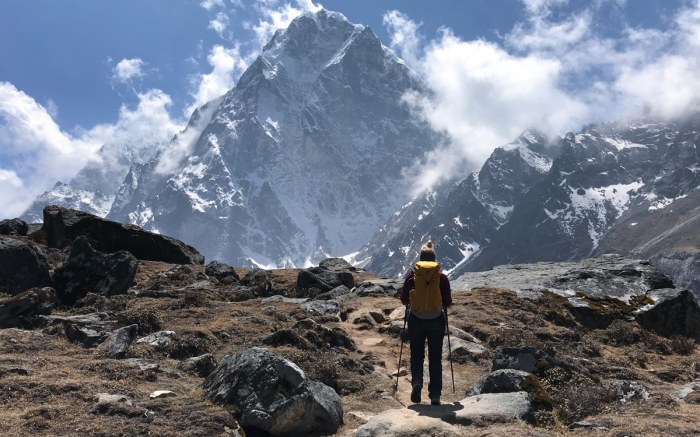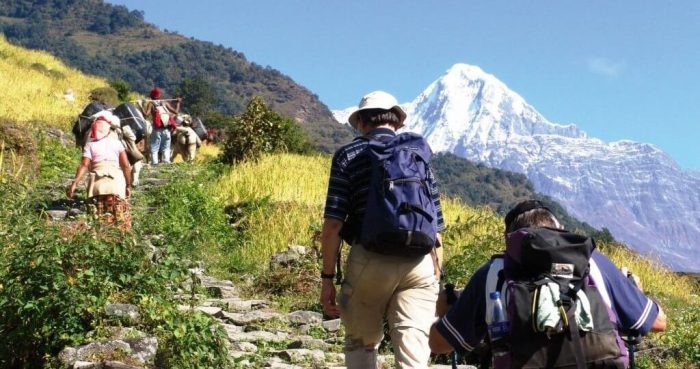
Embark on a journey through the breathtaking landscapes of Nepal with our guide to the most popular trekking routes in the region. From snow-capped peaks to lush valleys, get ready to discover the wonders of the Himalayas on foot!
Whether you’re a seasoned trekker or a novice adventurer, there’s something for everyone on these iconic trails that showcase the beauty and diversity of Nepal’s terrain.
Popular trekking routes in Nepal
Nepal is a paradise for trekkers, offering a plethora of breathtaking routes that cater to all levels of experience. From the towering peaks of the Himalayas to lush green valleys, each trekking route in Nepal has its own unique charm and challenges.
1. Everest Base Camp Trek
The Everest Base Camp Trek is one of the most iconic treks in the world, offering stunning views of Mount Everest and the surrounding peaks. This trek is considered moderate in difficulty, with altitude being the main challenge. The best time to trek to Everest Base Camp is during the spring (March to May) and autumn (September to November) seasons when the weather is clear and stable.
2. Annapurna Circuit Trek
The Annapurna Circuit Trek is a classic trek that takes you through diverse landscapes, from lush forests to arid highlands. This trek is of moderate difficulty, with the highest point being Thorong La Pass at 5,416 meters. The best time to trek the Annapurna Circuit is during the autumn and spring seasons for clear skies and pleasant weather.
3. Langtang Valley Trek
The Langtang Valley Trek is a less crowded but equally rewarding trek that offers stunning views of the Langtang range. This trek is considered moderate in difficulty, with the highest point being Kyanjin Ri at 4,773 meters. The best time to trek to Langtang Valley is during the spring and autumn seasons for mild temperatures and blooming rhododendrons.
4. Manaslu Circuit Trek
The Manaslu Circuit Trek is a remote and challenging trek that takes you around the eighth highest mountain in the world, Mount Manaslu. This trek is considered difficult due to its rugged terrain and high altitudes. The best time to trek the Manaslu Circuit is during the autumn and spring seasons for clear views and stable weather.
5. Upper Mustang Trek
The Upper Mustang Trek is a unique trek that takes you to the ancient kingdom of Lo Manthang, a hidden gem in the Himalayas. This trek is of moderate difficulty, with the main challenge being the high altitude desert terrain. The best time to trek to Upper Mustang is during the spring and autumn seasons for clear skies and comfortable temperatures.
Festival Travel in Nepal
Nepal is a land of vibrant festivals that hold deep cultural significance. These festivals often coincide with the popular trekking seasons, offering a unique opportunity for trekking enthusiasts to immerse themselves in the rich traditions and celebrations of the local communities.
Major Festivals in Nepal
- Tihar (Deepawali): Also known as the Festival of Lights, Tihar is a five-day long celebration that falls in October or November. Trekking enthusiasts can witness beautiful decorations, colorful lights, and traditional rituals during this festival.
- Dashain: Dashain is the biggest festival in Nepal, usually celebrated in September or October. It is a time for family gatherings, feasting, and worship. Travelers can experience the festive atmosphere in villages and towns along the trekking routes.
- Indra Jatra: This festival, dedicated to the Hindu god Indra, takes place in Kathmandu in September. Trekking enthusiasts can witness vibrant processions, cultural dances, and the living goddess Kumari during this festival.
Incorporating Festival Experiences into Trekking Itineraries
Trekking enthusiasts can plan their itineraries to coincide with major festivals in Nepal to get a taste of the local culture and traditions. They can participate in festivities, observe rituals, and interact with locals to enhance their trekking experience.
Cultural Significance of Festivals in Relation to Trekking
These festivals offer a glimpse into the religious beliefs, traditions, and values of the Nepalese people. By experiencing festivals during trekking expeditions, travelers can gain a deeper understanding of the local culture and forge connections with the communities along the trekking routes.
Tips for Navigating Crowds During Festival Seasons While Trekking
- Plan ahead and book accommodations in advance to avoid last-minute hassles.
- Avoid trekking in popular areas during peak festival days to minimize crowds.
- Respect local customs and traditions during festivals to ensure a harmonious experience.
- Stay flexible with your itinerary to adjust to any festival-related events or closures.
Mountain Trekking

When it comes to mountain trekking in Nepal, proper equipment and physical fitness are essential for a safe and enjoyable experience. In this section, we will discuss the necessary gear, fitness levels required for different routes, comparison with other mountain ranges, and safety tips for your mountain trekking adventures.
Equipment and Gear
- Sturdy hiking boots with ankle support
- Warm and moisture-wicking clothing layers
- Sleeping bag suitable for cold weather
- Trekking poles for stability
- Sunscreen, sunglasses, and a hat
- First aid kit
- Water purification tablets
Physical Fitness Levels
Mountain trekking routes in Nepal vary in difficulty, from moderate to strenuous. It is important to assess your fitness level before embarking on a trek and choose a route that matches your capabilities.
Experience in the Himalayas vs. Other Mountain Ranges
Trekking in the Himalayas offers a unique experience due to the stunning landscapes, diverse culture, and challenging terrain. The Himalayas are known for their towering peaks and remote trails, providing a sense of adventure unlike any other mountain range.
Safety Tips
- Acclimatize properly to prevent altitude sickness
- Stay hydrated and eat well-balanced meals
- Follow the guidance of experienced guides
- Be prepared for changing weather conditions
- Inform someone of your trekking plans and expected return date
Mountain Retreats

In Nepal, there are numerous high-altitude mountain retreats that offer a peaceful and rejuvenating experience for trekkers looking to rest and recharge during their journey through the Himalayas.Mountain retreats in Nepal provide basic amenities such as cozy accommodations, hot meals, and warm hospitality in a serene environment surrounded by breathtaking mountain views. These retreats often have simple yet comfortable rooms equipped with necessary facilities like clean bedding, hot showers, and sometimes even Wi-Fi connectivity.Staying at a mountain retreat during a trek offers several benefits to trekkers.
It allows them to acclimatize to the high altitude, rest tired muscles, and enjoy the tranquility of the mountains. Additionally, it provides an opportunity to interact with fellow trekkers and share experiences, making the journey more enriching and memorable.Moreover, mountain retreats play a vital role in promoting sustainable tourism in Nepal. By supporting local communities and preserving the natural environment, these retreats contribute to the conservation of the Himalayan ecosystem.
They also provide employment opportunities to locals and help in the economic development of rural areas, ensuring a harmonious relationship between tourism and the environment.
List of High-Altitude Mountain Retreats in Nepal:
- Yeti Mountain Home, Namche
- Langtang View Hotel, Kyanjin Gompa
- Gokyo Resort, Gokyo Valley
- Annapurna Sanctuary Lodge, Annapurna Region
Wildlife Holidays in Nepal
Nepal is not only known for its stunning mountain landscapes but also for its rich biodiversity and wildlife reserves that offer unique opportunities for wildlife enthusiasts.
Popular Wildlife Reserves in Nepal
- Chitwan National Park: Famous for its population of endangered one-horned rhinoceros and Bengal tigers.
- Bardia National Park: Home to diverse wildlife including elephants, leopards, and the rare Gangetic dolphins.
- Koshi Tappu Wildlife Reserve: A haven for birdwatchers with over 500 species of birds found in the area.
Unique Wildlife Species in Nepal
- Snow Leopard: Found in the higher altitudes of the Himalayas, known for its elusive nature.
- Red Panda: A rare and endangered species, often spotted in the forests of Nepal.
- Asian Elephant: Frequently sighted in the national parks, especially in Chitwan and Bardia.
Conservation Efforts in Nepal
- Community-based conservation projects involving local communities in wildlife protection efforts.
- Anti-poaching measures to combat illegal wildlife trade and protect endangered species.
- Eco-tourism initiatives promoting sustainable tourism practices to minimize impact on wildlife habitats.
Responsible Wildlife Viewing Tips
- Observe wildlife from a safe distance to avoid disturbing their natural behavior.
- Do not feed or approach wild animals as it can be harmful to both the animals and humans.
- Follow the guidelines set by park authorities and experienced guides for responsible wildlife viewing.
Wrap-Up
As you plan your next trekking adventure, remember that Nepal offers a plethora of options for every type of traveler. Whether you seek a challenging trek or a leisurely stroll amidst nature, the popular trekking routes in Nepal are sure to leave you spellbound with their charm and allure.
FAQ Overview
Is it safe to trek in Nepal?
Yes, trekking in Nepal is generally safe, but it’s essential to be prepared, follow local guidelines, and hire experienced guides.
What is the best time to trek in Nepal?
The best time for trekking in Nepal is during the spring (March to May) and autumn (September to November) seasons when the weather is pleasant and the skies are clear.
Are permits required for trekking in Nepal?
Yes, trekkers need to obtain permits for most trekking routes in Nepal to ensure conservation efforts and monitor visitor numbers in protected areas.
What is the difficulty level of trekking in the Himalayas?
Trekking in the Himalayas can vary from easy to extremely challenging, depending on the route chosen. It’s important to assess your fitness level and choose a suitable trek accordingly.
Can I trek solo in Nepal?
While it’s possible to trek solo in Nepal, especially on popular routes, it’s recommended to trek with a guide or in a group for safety and navigation purposes.





